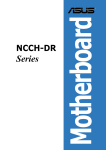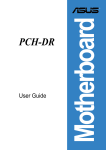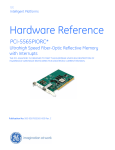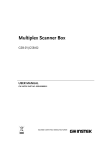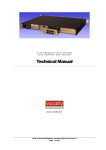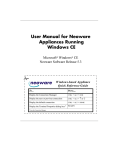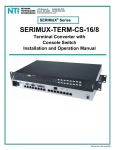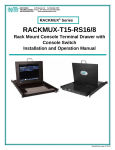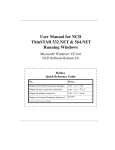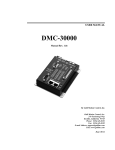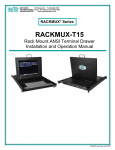Download Echo EN55022 User's Manual
Transcript
5SX_ LANlink Router Option User Manual WARNING - BEFORE INSTALLATION, PLEASE REFER TO SAFETY INSTRUCTIONS IN APPENDIX A, AND EMC INSTRUCTIONS IN APPENDIX C Certified Compliant in the EC, when fitted in accordance with the installation instructions, against the following directives/standards: Low Voltage Directive (73/23/EEC and amendment 93/68/EEC) EN60950 : 1992 (Safety) Electromagnetic Compatibility subsequent amendments to date): EN55022 EN50082-1 directive (89/336/EEC and : 1994 (Emissions) : 1992 (Immunity) directive Telecommunications Terminal Equipment (91/263/EEC and amendment 93/68/EEC) where indicated in approvals requirements section. Part Number: EA88001A Echo LANlink Router Option User Manual Issue 1.0 04 December 1997 Page 2 of 59 CONTENTS 1 INTRODUCTION.................................................................... 6 1.1 1.2 Functional Overview............................................................................. 7 Typical Applications ............................................................................. 7 2 USE AND CONFIGURATION................................................ 9 2.1 2.2 2.3 2.4 2.4.1 2.4.2 2.5 2.5.1 2.5.2 2.5.3 2.6 2.6.1 2.6.2 2.6.3 2.6.4 2.6.5 2.6.6 2.6.7 2.6.8 2.6.9 Router Configuration ............................................................................ 9 Supervisor Terminal Requirements ...................................................... 9 Router Terminal Display....................................................................... 9 Router Management ........................................................................... 11 General Keyboard Conventions .................................................. 11 Parameter Selection.................................................................... 11 Multiplexer Management .................................................................... 13 Allocating bandwidth to the Router ............................................. 13 Returning to the Main Menu Screen............................................ 14 Clearing the Configuration back to Factory Default .................... 14 System Status..................................................................................... 14 MAIN LINK CARRIER LOSS ....................................................... 15 D/I CARRIER LOSS .................................................................... 15 REMOTE ALARM........................................................................ 15 Nx64 CHANNEL x CONTROL DISAFFIRMED............................ 15 Nx64 CHANNEL x CLOCK FAIL ................................................. 15 MAIN LINK HIGH BIT ERROR RATE.......................................... 15 LOCAL/REMOTE MAP MISMATCH............................................ 15 D/I REMOTE ALARM .................................................................. 15 ROUTER WAN LINK STATUS.................................................... 16 3 INSTALLATION ................................................................... 17 3.1 3.2 3.3 3.4 3.5 3.6 3.7 3.7.1 3.7.2 Opening the Multiplexer ..................................................................... 17 Internal Link LK13 .............................................................................. 18 Installing the Router Option................................................................ 18 Testing................................................................................................ 19 Data Connections............................................................................... 19 Front Panel LEDs ............................................................................... 19 Quick Configuration............................................................................ 20 Multiplexer Configuration ............................................................ 20 Router Configuration ................................................................... 20 4 ROUTER MENU OPTIONS ................................................. 23 4.1 UNIT STATUS .................................................................................... 23 4.2 TRAFFIC ANALYSIS .......................................................................... 24 4.2.1 IP: ROUTING TABLE .................................................................. 24 4.2.2 IP: ARP TABLE ........................................................................... 25 4.2.3 IPX: RIP TABLE .......................................................................... 26 Echo LANlink Router Option User Manual Issue 1.0 04 December 1997 Page 3 of 59 4.2.4 4.2.5 4.3 4.4 4.4.1 4.4.2 4.4.3 4.4.4 4.5 4.6 4.6.1 4.6.2 4.7 4.7.1 4.7.2 4.7.3 4.7.4 4.7.5 4.8 4.8.1 4.8.2 IPX: SAP TABLE ......................................................................... 27 SHOW TRAFFIC DETAILS ......................................................... 28 NETWORK LOADING ........................................................................ 28 REMOTE MANAGEMENT.................................................................. 29 TELNET OUT .............................................................................. 29 NAME SERVER CONFIGURATION............................................ 29 SECURITY .................................................................................. 30 SNMP SETUP ............................................................................. 31 UNIT CONFIGURATION .................................................................... 31 SERVICE SETUP ............................................................................... 32 ETHERNET SERVICE SETUP.................................................... 32 WAN SERVICE SETUP .............................................................. 34 FILTER SETUP .................................................................................. 36 MAC FILTERS (WAN or Ethernet) .............................................. 36 IP FILTER (WAN or Ethernet) ..................................................... 37 IPX SAP FILTER MENU (WAN or Ethernet) ............................... 38 IPX HEADER FILTERS ............................................................... 40 NOVELL KEEP-ALIVES .............................................................. 41 EVENTS ............................................................................................. 41 PPP EVENTS .............................................................................. 42 SYSTEM EVENTS....................................................................... 42 Appendix A WARNINGS............................................................. 44 Appendix B APPROVAL REQUIREMENTS .............................. 47 Appendix C EMC REQUIREMENTS .......................................... 48 Appendix D REAR PANEL LAYOUT ......................................... 49 Appendix E AUI PORT (15-WAY D-TYPE) PINOUT.................. 50 Appendix F 10BASE-T (RJ45) PORT PINOUT.......................... 51 Appendix G IP FILTER EXAMPLES........................................... 52 Appendix H IP SUBNETS ........................................................... 55 Appendix I ROUTER MAINTENANCE MENU .......................... 56 Echo LANlink Router Option User Manual Issue 1.0 04 December 1997 Page 4 of 59 GLOSSARY ADPCM ARP ARPA ASCII BER BOOTP bps CHAP CRC D&I DNS EEPROM FAS GND ICMP IP IPX LAN LED MAC NCP PABX PAP PC PCM PPP RIP SAP SELV SKT SNMP TCP TDM TFTP UDP WAN Adaptive Differential Pulse-Code Modulation Address Resolution Protocol Advanced Research Projects Agency American Standard Code for Information Interchange Bit Error Rate Bootstrap Protocol bits per second Challenge Handshake Authentication Protocol Cyclic Redundancy Check Drop and Insert Domain Name Server Electrically Erasable Programmable Read-Only Memory Frame Alignment Synchronisation Ground Internet Control Message Protocol Internet Protocol Internetwork Packet Exchange Local Area Network Light Emitting Diode Media Access Control NetWare Core Protocol Private Automatic Branch Exchange Password Authentication Protocol Personal Computer Pulse Code Modulation Point to Point Protocol Routing Information Protocol Server Advertising Protocol Safety Extra Low Voltage Socket Simple Network Management Protocol Transmission Control Protocol Time Division Multiplexer Trivial File Transfer Protocol User Datagram Protocol Wide Area Network Echo LANlink Router Option User Manual Issue 1.0 04 December 1997 Page 5 of 59 Echo LANlink Router Option User Manual 1 INTRODUCTION This user manual describes installation, configuration and operation of the Echo LANlink Multiplexer Router option, and must be referred to in conjunction with the Echo LANlink Multiplexer User Manual. The Echo LANlink is an E1 time division multiplexer (TDM) operating at 2Mbps compliant with both EUROPEAN and UK G.703 communications standards. The Router Option card adds the capability of connecting two Local Area Networks (LANs), via the E1 communication link, using some or all of the link bandwidth. A Router Option card needs to be installed inside the Echo LANlink at both ends of the communications link. Each Router examines addressing information on each LAN, and on recognition of an address on the distant LAN, forwards the frame via the communication link, thereby linking the two LANs together (see Figure 1). Figure 1 Linking two LANs together Echo LANlink Router Option User Manual Issue 1.0 04 December 1997 Page 6 of 59 The Router Option card is easily configured using the management terminal connected to the Echo LANlink from either end of the link, or through Telnet at a relevant workstation either LAN. 1.1 Functional Overview The Router Option card supports both transceiver connection (AUI port) and hub (10BASE-T port) connection to a 10MHz Ethernet LAN. Ethernet frames are transported to/from the remote LAN using some or all of the main communications link bandwidth. The bandwidth is allocated in 64Kbps timeslots amongst the various functions of the multiplexer as required by the user. Up to 1984Kbps free bandwidth is available on an E1 link, 64Kbps is permanently assigned for E1 frame synchronisation and signalling. The router supports both the popular Internet Protocol (IP) and Internetwork Packet Exchange (IPX) protocols. Many other protocols may be used encapsulated by these as required: e.g. TCP, UDP, and NetWare. The router maintains dynamic routing tables so that Ethernet frames are routed to their correct destination. This capability is performed automatically by the router as it “learns” routes and addresses available in the network. The router will also broadcast its own routing information to other devices on the network. Inoperative routes will time-out and be removed from the routing tables so that alternative routes may be used in the event a communications circuit failure. A data compression algorithm is used when transporting Ethernet frames through the communications link to increase the throughput of data. Comprehensive filtering options are available so the router may act as a sophisticated firewall to give added security for the LAN. 1.2 Typical Applications The simplest application for the Router Option is to link two LANs as shown in Figure 1. In this example, the Branch Office is linked to the Headquarters via the Echo LANlinks and users at the Branch office will be able to access the General Servers as if they were on the same network. Further use of the router functionality can give sophisticated security for network elements. Restrictive firewalls are easily built using subnet masking. Entire subnets can be isolated from the network by simply entering appropriate configurations – see Figure 2. In this example the Salesperson in Echo LANlink Router Option User Manual Issue 1.0 04 December 1997 Page 7 of 59 the Branch Office could access the Headquarters General Server via the Echo LANlink, but accesses to the Finance Server could be stopped using subnet masking in the Echo LANlink. Figure 2 Restrictive Firewall Example In addition to the features of the router, all the existing functions of the Echo LANlink are still available. This means that as well as connecting two remote LANs, the Echo LANlink can also carry PABX voice traffic (using D&I option card or ADPCM option card), and data traffic between the two sites, all simultaneously multiplexed onto one E1 communication link. Echo LANlink Router Option User Manual Issue 1.0 04 December 1997 Page 8 of 59 2 USE AND CONFIGURATION This section covers connection and set-up of the Echo LANlink Router Option, and must be used in conjunction with the Echo LANlink User Manual. If you are not familiar with the general configuration procedure for the Echo LANlink, please refer to that manual before reading further and attempting to configure the Router Option. 2.1 Router Configuration The Router is initially configured using an asynchronous terminal, or PC using a suitable terminal emulation package such as Windows Terminal. The terminal should be connected via its serial port to the SUPERVISOR port on the rear of the Echo LANlink (see Echo LANlink User Manual). 2.2 Supervisor Terminal Requirements The terminal should be configured as follows: 8 bit character, no parity, one stop bit, speed 9.6Kbps, 2.3 Router Terminal Display After power up, the terminal will display the following message: login: Either type in the factory default login, mgr, or your login name if one has previously been set and press <return>. The system will also prompt for a password if one has been set - initially no password is required, but password protection of the router configuration system is imperative to reduce the risk of unauthorized changes. The set-up of a password is covered later. The terminal will then display the following question. Default terminal VT 100/220/320/420. OK (y or n)? Echo LANlink Router Option User Manual Issue 1.0 04 December 1997 Page 9 of 59 If you are using a terminal from this list type y <return>, or alternatively press n <return> to enter another type: supported terminal types are shown in Figure 3 - type one of them in to select a suitable terminal type and press <return> VT100 VT220 VT320 VT420 FALCO Figure 3 SUNVIEW SUN WYSE50 A210 TVI925 TVI910 Supported Terminal Types Once a terminal type has been selected, the main menu screen shown in Figure 4 will be displayed. Using the keyboard arrow keys you should be able to move the highlighted cursor between the various menu items. If this is not the case, or the display is corrupted, it may be because the terminal type is incorrect, or the terminal settings are wrong. In this case, pressing L followed by <return> should lead you back to the login prompt. +-------------------------------------------------------------------------------+ | UNIT: S1234 LOGOUT | +-------------------------------------------------------------------------------+ ROUTER MANAGEMENT MULTIPLEXER MANAGEMENT NONE SYSTEM STATUS NO ALARMS Figure 4 Main Menu Screen The Echo LANlink with Router Option is configured in two parts: Router Management (for all the router functions) and Multiplexer Management (for all the multiplexer functions). Echo LANlink Router Option User Manual Issue 1.0 04 December 1997 Page 10 of 59 2.4 Router Management Selecting ROUTER MANAGEMENT from the main menu allows the user to configure the router. The router management screen is shown in Figure 5. Refer to Section 4 for details on each menu option. +-------------------------------------------------------------------------------+ | ROUTER: S1234 EXIT | +-------------------------------------------------------------------------------+ UNIT STATUS TRAFFIC ANALYSIS NETWORK LOADING REMOTE MANAGEMENT UNIT CONFIGURATION SERVICE SETUP FILTER SETUP EVENTS Figure 5 Router Management Screen 2.4.1 General Keyboard Conventions The following keys are used to navigate the configuration screens for the router management. Æ Å Ç È Moves the cursor block to the right Moves the cursor block to the left Moves the cursor block upwards Moves the cursor block downwards <return> selects/initiates the highlighted option 2.4.2 Parameter Selection When a command is selected from the command line using the cursor, pressing <return> will initiate action. Some commands require the user to enter data. In Figure 6, a user has selected to ADD a new WAN IP filter. A new line has appeared allowing the user to enter the source IP address for the WAN filter. In this case, type in the required value using the keyboard and press <return>. Press <esc> to cancel any data entry operation Echo LANlink Router Option User Manual Issue 1.0 04 December 1997 Page 11 of 59 +-------------------------------------------------------------------------------+ | WAN IP FILTER 1 - WAN IP FILTER 1: S1234 EXIT | | ADD EDIT DELETE CLEAR NAME | +-------------------------------------------------------------------------------+ ENTER THE SOURCE I.P. ADDRESS (RETURN = ALL): LINE SRC ADDR SRC MASK DEST ADD DEST MASK PROT S.PRT D.PRT RSLT Figure 6 Entering a Parameter Echo LANlink Router Option User Manual Issue 1.0 04 December 1997 Page 12 of 59 2.5 Multiplexer Management Selecting MULTIPLEXER MANAGEMENT from the main menu allows the user to configure the multiplexer functions. If another user is currently accessing the multiplexer management page (e.g. via a Telnet session) this will be indicated next to the menu item. Only one session is allowed access to the multiplexer functions at any one time. If NONE is displayed the user is free to enter multiplexer management. If an IP address is displayed, then this is the address of the user currently accessing the multiplexer functions. If CONSOLE is displayed, then the multiplexer functions are being accessed via the multiplexer supervisor port. You may choose to break their session if absolutely necessary but this should be used with caution. Figure 7 shows the main multiplexer configuration page. Refer to the Echo LANlink User manual for details on how to configure the multiplexer. New options that are available when the Router Option is fitted are detailed below. 2 MEGABIT E1 MULTIPLEXER V1.04 ================================ 00:00 25/12/97 =============================== Main Link (UK) : SYNCHRONISED Exit to Router: Mode : NORMAL * Nx64 Channels : 2 + ROUTER Framing : CRC4 D&I Channels : NOT FITTED Idle Bandwidth : 1984K Alarms : None Clock Reference : INTERNAL Statistics : Main Link Configuration :>LOCAL Events : Log Nx64 Channel : 1 2 ROUTER Rate : OFF OFF OFF Mode : NORMAL NORMAL Tx Clock : INT INT Rx Clock : INT INT Indicate : ON ON Control : ON ON ------------------------TIMESLOT MAP--------------------------0 0 0 0 0 0 0 0 0 0 1 1 1 1 1 1 1 1 1 1 2 2 2 2 2 2 2 2 2 2 3 3 0 1 2 3 4 5 6 7 8 9 0 1 2 3 4 5 6 7 8 9 0 1 2 3 4 5 6 7 8 9 0 1 --------------------------------------------------------------S - - - - - - - - - - - - - - - - - - - - - - - - - - - - - - Cursor keys to move, CTRL-U to save, ESC to abandon =============================================================================== Use <SPACEBAR>/<+>/<-> to select Figure 7 Main Multiplexer Configuration Page 2.5.1 Allocating bandwidth to the Router The amount of bandwidth allocated to the router determines the throughput of Ethernet data through the router. Bandwidth is allocated using the timeslot map on the multiplexer Nx64 Channels page. Typing ‘R’ in the timeslot map will assign that timeslot to the router. Any combination of timeslots may be allocated to the router (except timeslot 0, which is always reserved) and each timeslot assigned will contribute 64Kbps of bandwidth. The Rate field for the router will automatically be updated to show the bandwidth assigned. Echo LANlink Router Option User Manual Issue 1.0 04 December 1997 Page 13 of 59 Figure 8 shows an example timeslot set-up with 512Kbps allocated to channel 1, 320Kbps allocated to channel 2, and 1152Kbps allocated to the router. 2 MEGABIT E1 MULTIPLEXER V1.04 ================================ 00:00 25/12/97 =============================== Main Link (UK) : SYNCHRONISED Exit to Router: Mode : NORMAL * Nx64 Channels : 2 + ROUTER Framing : CRC4 D&I Channels : NOT FITTED Idle Bandwidth : 0K Alarms : None Clock Reference : INTERNAL Statistics : Main Link Configuration :>LOCAL Events : Log Nx64 Channel : 1 2 ROUTER Rate : 512K 320K 1152K Mode : NORMAL NORMAL Tx Clock : INT INT Rx Clock : INT INT Indicate : ON ON Control : ON ON ------------------------TIMESLOT MAP--------------------------0 0 0 0 0 0 0 0 0 0 1 1 1 1 1 1 1 1 1 1 2 2 2 2 2 2 2 2 2 2 3 3 0 1 2 3 4 5 6 7 8 9 0 1 2 3 4 5 6 7 8 9 0 1 2 3 4 5 6 7 8 9 0 1 --------------------------------------------------------------S R 1 R 1 R R 2 2 R R R R R R R R R R R 1 1 1 1 1 1 R R R 2 2 2 Cursor keys to move, CTRL-U to save, ESC to abandon =============================================================================== Use <SPACEBAR>/<+>/<-> to select Figure 8 Example Timeslot Set-up 2.5.2 Returning to the Main Menu Screen Selecting the Exit to Router menu option will return the user back to the main menu screen. If any unsaved changes have been left, a prompt will appear to confirm the action, as any unsaved changes will be lost after leaving the multiplexer management page. 2.5.3 Clearing the Configuration back to Factory Default The multiplexer may be reset back to the factory default configuration by pressing CTRL-R four times when the cursor is on the Configuration item. A confirm message will be displayed before the configuration is reset. The previous configuration will be lost. 2.6 System Status The main menu SYSTEM STATUS item displays the alarm status of the overall system. Selecting this item gives the status of all the alarms in the system as detailed below. Note the router monitors the alarm status of the multiplexer and therefore the alarms have to be configured under multiplexer management to be valid. Echo LANlink Router Option User Manual Issue 1.0 04 December 1997 Page 14 of 59 2.6.1 MAIN LINK CARRIER LOSS The local Multiplexer cannot identify a valid synchronisation sequence (FAS, CRC4 etc) from the remote multiplexer. 2.6.2 D/I CARRIER LOSS The Multiplexer cannot identify a valid synchronisation sequence (FAS, CRC4 etc) from the unit attached to the D&I port. 2.6.3 REMOTE ALARM The unit attached to the D&I port is generating an alarm in the framing information, that is, it is reporting that it has a problem. 2.6.4 Nx64 CHANNEL x CONTROL DISAFFIRMED One of the channel ports (which is in use) is not providing the multiplexer with a true CONTROL signal. This may mean that the signals have not been connected at all. Note that unconnected CONTROL inputs will produce a random ON or OFF indication. Control inputs from ports that are not allocated in the timeslot map are ignored. 2.6.5 Nx64 CHANNEL x CLOCK FAIL One of the data channels cannot synchronise its clock to the global network clock. This may occur if a channel is set to external clock, and either no clock at all is connected, or the clock that is connected is the wrong rate. 2.6.6 MAIN LINK HIGH BIT ERROR RATE Shows FAULT if the Bit Error Rate exceeds the threshold set. With an error free link, this fault will eventually clear when the BER becomes less than the threshold set. 2.6.7 LOCAL/REMOTE MAP MISMATCH The configuration in the local unit does not match that in the remote unit. This would almost certainly lead to data errors on some channels. 2.6.8 D/I REMOTE ALARM The unit attached to the D&I port is generating an alarm in the framing information, that is, it is reporting that it has a problem. Echo LANlink Router Option User Manual Issue 1.0 04 December 1997 Page 15 of 59 2.6.9 ROUTER WAN LINK STATUS The status of the link between the two routers is displayed. Echo LANlink Router Option User Manual Issue 1.0 04 December 1997 Page 16 of 59 3 INSTALLATION WARNING – Refer to Appendix A for Safety Instructions. WARNING - The multiplexer must be disconnected from the power supply and all peripheral connections before opening. 3.1 Opening the Multiplexer With the power cord and all peripherals DISCONNECTED, the screws on the left, right and top of the multiplexer are removed using a Pozidrive screwdriver to gain access to the interior of the multiplexer. This allows installation of the option cards J15 J10 Figure 9 LK13 Echo LANlink Baseboard Echo LANlink Router Option User Manual Issue 1.0 04 December 1997 Page 17 of 59 3.2 Internal Link LK13 Locate the internal connector LK13 on the motherboard (refer to Figure 9). This will be fitted with shorting links if the Echo LANlink was supplied without the Router Option. Remove the shorting links before fitting the Router Option. The links may be repositioned on one pin for storage. 3.3 Installing the Router Option Remove the option blanking plate above the CH 1 and CH2 connectors on the rear panel of the multiplexer. The blanking plate may be discarded if not required. The Router Option card should be carefully fitted in the position shown in Figure 10, connecting to J10 and J15 on the motherboard (refer to Figure 9). The Router Option power connector (flying lead) should be connected to J12 (ensure correct polarisation). Refit the rear panel screws to secure the option card Router Option Figure 10 J12 Echo LANlink showing Router Option Fitted Echo LANlink Router Option User Manual Issue 1.0 04 December 1997 Page 18 of 59 3.4 Testing Replace the cover and screws before powering up the unit. Correct installation of the Router Option may be confirmed by the login prompt (see section 2.3) appearing on the terminal screen. If the red error LED on the front panel is on, this indicates hardware fault has occurred. In this case, disconnect the power cable and check the installation of the Router Option is correct. 3.5 Data Connections The Ethernet connection is made using either the AUI (15-way D-type – see Appendix E) or 10BASE-T (RJ45 see Appendix F) port at the rear of the unit (refer to Appendix D). 3.6 Front Panel LEDs For information regarding CARRIER, MAJOR ALARM, MINOR ALARM and LOOP, refer to the Echo LANlink User Manual. LED Label Notes TX DATA Flashes when unit is transmitting Ethernet data RX DATA Flashes when unit is receiving Ethernet data COLLISION Flashes if an Ethernet collision is detected FAULT RED if a power up hardware fault has occurred Echo LANlink Router Option User Manual Issue 1.0 04 December 1997 Page 19 of 59 3.7 Quick Configuration The first stage in configuration is to allocate some bandwidth of the communication link to the router. The second stage is to configure the SERVICE SETUP to allow communication between the two routers. 3.7.1 Multiplexer Configuration From the main menu enter MULTIPLEXER MANAGEMENT. Allocate bandwidth to the router by entering ‘R’ in any free timeslot positions near the bottom of the screen. Each timeslot allocated will contribute 64Kbps of bandwidth to the router. Save the multiplexer configuration using CTRL-U. Leave MULTIPLEXER MANAGEMENT by selecting Exit to Router at the top right of the screen. 3.7.2 Router Configuration From the main menu enter ROUTER MANAGEMENT. Go into SERVICE SETUP and enter ETHERNET SERVICE. The following parameters need to be set. N.B. IP service must be configured even when IP is not being used on the local Ethernet network. 3.7.2.1 Service Name A name to identify the local Ethernet Network, this is displayed in the IP RIP, IPX RIP and IPX SAP tables and should ideally refer to network location. 3.7.2.2 IP Address A unique address within the IP network connected to the local Ethernet port. This is the IP Address of the Router and is used as the gateway address for routing between the local Ethernet network and the WAN link. 3.7.2.3 IP Subnet Bits The Subnet Bits should be set if subnetting is to be used on the local network, otherwise the default 0 should be used. Echo LANlink Router Option User Manual Issue 1.0 04 December 1997 Page 20 of 59 3.7.2.4 Receive IP RIP To enable routes to destinations within the local network to be added to the routing table this field should be set to the appropriate protocol; NONE, RIP1, RIP2 or both RIP1 and RIP2. If the RIP version is unknown then set BOTH. 3.7.2.5 Transmit IP RIP To allow the Router to propagate routes learnt from the WAN to the local network, this field must be set to the correct value for the RIP protocol being used or to NONE to disable RIP transmission. Available options include NONE, RIP1, RIP1 compatible or RIP2. 3.7.2.6 IP Broadcast This field enables the IP broadcast bits to be set to either all ones or all zeroes depending on the requirements of the local Ethernet equipment. Normally this would be set to All Ones. 3.7.2.7 IP Filter The IP Filter is used to prevent specific IP packets being transmitted over the WAN link. The Filter Table is defined in the Static Routes and Filter Setup Menu. For initial configuration this field should be left set to NO until the Filter Table entries are defined. Set to YES, the default action of an empty Filter Table is to block all IP transmissions. 3.7.2.8 IPX Configuration If IPX (Internetworking Protocol Exchange) is not being used then these fields can be left at their default values to disable. 3.7.2.9 IPX Network Number If there is no file server on the local Ethernet then the network number must be specified. If a local file server is present the Network Number can be left set to zero, and the Router will auto-sense the number when connected. 3.7.2.10 IPX Frame Types The default frame type is Ethernet 802.3. If 802.2 is required this setting can be changed. Echo LANlink Router Option User Manual Issue 1.0 04 December 1997 Page 21 of 59 3.7.2.11 Receive IPX RIP Set this field to YES to receive IPX RIP responses from other routers or servers on the local network. 3.7.2.12 Transmit IPX RIP Set this field to YES to transmit regular IPX RIP responses to other routers or servers on the local network. If set to NO, IPX RIP responses will only be sent as a result of receiving a RIP request. 3.7.2.13 Receive IPX SAP Set this field to YES if you wish to receive IPX SAP responses from other routers or servers on the local network. Requests are still received and replied to. 3.7.2.14 Transmit IPX SAP Set to YES to allow transmission of regular IPX SAP responses to other routers or servers on the local network. If set to NO, IPX SAP responses will only be sent as a result of receiving a SAP request. 3.7.2.15 IPX SAP Filter The IPX SAP Filter is used to remove unwanted server entries from the SAP table and their propagation to the WAN link. If no filter table entries have been created and this option is set to YES, the default action is to ignore all SAP entries. Once configuration is complete, move the cursor to the EXIT position and press <return>. Echo LANlink Router Option User Manual Issue 1.0 04 December 1997 Page 22 of 59 4 ROUTER MENU OPTIONS The menu options allow the user to configure the router to individual requirements. The menu tree is shown in the diagram below, and each option is discussed in the following section. Login Prompt Router Management Unit Status Traffic Analysis Multiplexer Management Network Loading Remote Management Unit Configuration System Status Service Setup Filter Setup Events 4.1 UNIT STATUS This option displays statistics for the Ethernet and WAN links. At the top of the screen the unit name and time since power on are displayed. The user can use the CLEAR option to reset the data counts to begin new analysis or EXIT option to leave the page. The following table describes the parameters that are displayed: PARAMETER NAME STATE DESCRIPTION OPTIONS Ethernet segment name User defined WAN service name Port status for the ACTIVE Ethernet Interface FILTER Service status for WAN LINK DOWN Interfaces COMPRESSED IP MODE IPX MODE Current WAN IP routing ROUTE status BLOCK BRIDGE Current WAN IPX ROUTE routing status BLOCK BRIDGE Echo LANlink Router Option User Manual Issue 1.0 04 December 1997 Page 23 of 59 PARAMETER OTHER MODE Rx PACKET COUNT Rx PACKET ERROR Tx PACKET COUNT Tx PACKET OVERFLOW LINE SPEED DESCRIPTION OPTIONS Current OTHER BLOCK protocol routing status BRIDGE Number of packets seen on the segment connected to the port displayed. Number of packets received with CRC or Frame errors. Number of packets transmitted by Router. Number of packets discarded by Router owing to queue time exceeding the permitted maximum delay. Indicates the amount of bandwidth (in bps) allocated to the router by the multiplexer 4.2 TRAFFIC ANALYSIS Menu options available from the Traffic Analysis selection are detailed below. 4.2.1 IP: ROUTING TABLE This table displays the current IP routes in the routing table. Information in this table comes from four sources: 1. 2. 3. 4. The IP address of the router determines which network is physically connected to the Ethernet Port. RIP Packets received from the Ethernet Port. RIP Packets received from the WAN port. Static (permanent) entries entered by the user. The user can define up to 16 static routes in this table. The simplest means to allow the router to 'learn' network routes is to use IP RIP Receive. For configuration see the Ethernet Service Setup section. The user can then highlight all routes to be made static using the cursor and press <return>. The user will be prompted to either delete the entry or make it part of the Echo LANlink Router Option User Manual Issue 1.0 04 December 1997 Page 24 of 59 routing table. Turning off IP RIP Receive as before will cause other learned routes to age out after about four minutes. PARAMETER NETWORK SUBNET BITS/MASK GATEWAY SERVICE TIMER METRIC DESCRIPTION The IP Network number to which this RIP entry relates. This shows the subnet mask detected by the Router. The IP Address of the next gateway used in this route to send a packet to the specified network. The required service that must be used to reach a specified network. This will display the time interval in seconds, since this routing entry was last updated. For the attached Network this will be left blank. For static IP Routes this will be STATIC. This will indicate the number of nodes passed in the route to the Network. RIP packets pass on a value that is incremented at each node. The metric is used for selecting the best route if a multiple route network exists. 4.2.2 IP: ARP TABLE This table gives the current ARP table for the router. PARAMETER IP ADDRESS MAC ADDRESS TIMER Echo LANlink Router Option User Manual DESCRIPTION The IP Network number to which this entry relates. The MAC Address (Ethernet Address) associated with an IP address. If no MAC address is available “NONE” will be displayed. Displays the time interval in seconds since a routing entry was last updated. For the attached Network this will be left blank. Issue 1.0 04 December 1997 Page 25 of 59 4.2.3 IPX: RIP TABLE This table displays the current IPX routes in the IPX RIP table. Information in this table comes from four sources: 1. The IPX network number determines which network is physically attached to the Ethernet port. 2. IPX SAP Packets received from the Ethernet Port. 3. IPX SAP Packets received from the WAN port. 4. Static (permanent) entries entered by the user. The user can define up to 16 static routes in this table. The simplest means to allow the router to 'learn' available services is to use IPX RIP Receive. For configuration see the Ethernet Service Setup section. The user can then highlight all routes to be made static using the cursor and press <return>. The user will be prompted to either delete the entry or make it part of the IPX RIP table. Turning off IPX RIP Receive as before will cause other learned services to age out after about four minutes. PARAMETER IPX NETWORK SERVICE NODE HOPS TICKS TIMER Echo LANlink Router Option User Manual DESCRIPTION The IPX Network number to which this entry relates. The service that must be used to reach a specified Network. This is the Ethernet address of the next node on the route to the Network. This indicates the number of hops on the preferred route to the Network. This gives the delay in ticks (18 ticks/second) to be expected when communicating with the Network. This will display the time in seconds since the routing entry was last updated. For the attached Network this will be left blank. Issue 1.0 04 December 1997 Page 26 of 59 4.2.4 IPX: SAP TABLE This table displays the IPX services in the IPX SAP table. Information in this table comes from three sources: 1. IPX SAP Packets received from the Ethernet Port. 2. IPX SAP Packets received from the WAN port. 3. Static entries entered by the user. The user can define up to 16 static routes in this table. The simplest means to allow the router to 'learn' available services is to use IPX SAP Receive. For configuration see the Ethernet Service Setup section. The user can then highlight all services to be made static using the cursor and press <return>. The user will be prompted to either delete the entry or make it part of the IPX SAP table. Turning off IPX SAP Receive as before will cause other learned services to age out after about four minutes. PARAMETER TYPE NETWORK SERVICE NODE SOCKET HOPS TIMER NAME Echo LANlink Router Option User Manual DESCRIPTION Server identification number, defined by IPX e.g. file server: 4, print server: 47. Server network number. The service that must be used to reach a specified Network. Server node address. Node address socket number used to access the server. Number of hops in the preferred route to this server. Time interval in seconds, since this routing entry was last updated. For the attached Network, this will be left blank. This will display the time in seconds since the routing entry was last updated. For the attached Network this will be left blank. Issue 1.0 04 December 1997 Page 27 of 59 4.2.5 SHOW TRAFFIC DETAILS Displays a list of the current traffic received by the router. PARAMETER ADDRESS AGE FLAGS DESCRIPTION MAC address Time since packet last received L = local to the attached LAN H = addressed to this unit 4.3 NETWORK LOADING This option shows the load on the WAN and Ethernet ports over five second, one minute and five minute periods. PARAMETER AVERAGE PACKETS PEAK PACKETS AVERAGE BANDWIDTH PEAK BANDWIDTH Echo LANlink Router Option User Manual DESCRIPTION The average number of packets seen by the Router on a per second basis over the displayed time period at that port. The peak number of packets seen by the Router on a per second basis over the displayed time period. The average percentage of available bandwidth used by the segment or serial link attached to that port on a per second basis over the selected time period. The peak percentage of available bandwidth used by the segment or serial link attached to that port on a per second basis over the selected time period. Issue 1.0 04 December 1997 Page 28 of 59 4.4 REMOTE MANAGEMENT Selecting the Remote Management menu presents the user with the following four options. Unit Status Traffic Analysis Network Loading Remote Management Telnet Out Name Server Configuration Security SNMP Security Unit Configuration Service Setup Filter Setup Events View Name to IP Cache 4.4.1 TELNET OUT This option will enable telnet connection, by entering the relevant IP Address, to a remote workstation. 4.4.2 NAME SERVER CONFIGURATION This menu allows the user to configure the Router DNS Client features. PARAMETER TYPE DESCRIPTION The type of name server in use. OPTIONS NONE DNS SERVER IP The IP address of the name User defined ADDRESS server. IP TO NAME Type of mapping between REVERSE MAPPING MAPPING addresses and names. Some IN-ADDR.ARPA DOMAIN servers allow address entry to get names, in addition to entering names to get addresses (reverse mapping.) NAME TO IP If an address is requested from Go to Name to IP Cache CACHE the DNS server the Router Table caches the map. This map can therefore be viewed. Echo LANlink Router Option User Manual Issue 1.0 04 December 1997 Page 29 of 59 4.4.2.1 NAME TO IP CACHE PARAMETER IP ADDRESS NAME TIMER DESCRIPTION The name server IP address. The name associated to this IP address. If a name request is made to the DNS it will allocate a time period to retain the information. The timer shows how much time remains. 4.4.3 SECURITY PARAMETER CHANGE USER PASSWORD DESCRIPTION Allows user to change password. Old password must be entered prior to acceptance. OPTIONS USER PASSWORD User password access control. ENABLE USER CHANGE OWN PASSWORD User password change access control ENABLE USER LOGIN User access control ENABLE DISABLE DISABLE DISABLE USER TELNET LOGIN FROM Telnet access control NONE ANY IP ADDRESS IP NAME CHANGE MANAGER PASSWORD Factory SYSTEM. MANAGER PASSWORD Manager password access control ENABLE MANAGER TELNET LOGIN FROM Restricts Telnet access to the Router management to the following. Up to four IP names/addresses can be used. NONE Echo LANlink Router Option User Manual pre-set: Issue 1.0 ENTER NEW DISABLE ANY IP ADDRESS IP NAME 04 December 1997 Page 30 of 59 PARAMETER READ CONFIGURATION FROM DESCRIPTION Access permission to read configuration from the Router from external source. OPTIONS NONE ANY IP ADDRESS IP NAME EXTERNAL LOGIN UNIT External control unit access ENABLE DISABLE 4.4.4 SNMP SETUP PARAMETER COMMUNITY CONTACT NAME EQUIPMENT LOCATION SEND SNMP TRAPS TO DESCRIPTION SNMP Community: default PUBLIC Responsible for equipment. Useful to give telephone number. Allows rapid location of equipment when required. IP addresses of four SNMP stations. 4.5 UNIT CONFIGURATION PARAMETER ROUTER NAME ETHERNET ADDRESS UNIT SERIAL NUMBER SOFTWARE REVISION DEFAULT TERMINAL Echo LANlink Router Option User Manual DESCRIPTION User defined identification. Unique Ethernet address. Fixed serial number for Router option. Router software version/date. Default terminal type for access. Issue 1.0 04 December 1997 Page 31 of 59 4.6 SERVICE SETUP Unit Status Traffic Analysis Network Loading Remote Management Unit Configuration Ethernet Service Service Setup Filter Setup Events WAN Service PPP Setup PARAMETER ETHERNET SERVICE DESCRIPTION Brief summary of the LAN service available, including IP and IPX addresses as appropriate. Summary of traffic filters in use on WAN link. WAN SERVICE 4.6.1 ETHERNET SERVICE SETUP PARAMETER SERVICE NAME IP ADDRESS IP SUBNET BITS RECEIVE IP RIP TRANSMIT IP RIP DESCRIPTION User defined name for the local Ethernet network IP Address of the Router Ethernet Port. The number of subnet bits and subnet masks corresponding to this IP Address. Defines the type of RIP Packets received on the Ethernet Interface. OPTIONS NONE RIP 1 ONLY RIP 2 ONLY BOTH Defines the type of RIP NONE Packets used to RIP 1 ONLY transmit Routing RIP 1 COMP information RIP 2 ONLY BOTH Echo LANlink Router Option User Manual Issue 1.0 04 December 1997 Page 32 of 59 PARAMETER IP BROADCAST IP FILTER MAC FILTER IPX NETWORK IPX FRAME RECEIVE IPX RIP TRANSMIT IPX RIP RECEIVE IPX SAP TRANSMIT IPX SAP IPX SAP FILTER DESCRIPTION IP Broadcast Packet structure Enable or disable the IP Filter Table defined for the Ethernet port. N.B. If the IP filter table has no entries then all IP packets are ignored if enabled Enables or disables MAC filtering The Network number of the attached IPX network. IPX Packet Framing type This enables or disables the reception of IPX RIP Packets over the Ethernet This enables or disables the transmission of IPX Routing information over the Ethernet This enables or disables the reception of IPX SAP Packets over the Ethernet. This enables or disables the transmission of IPX SAP Packets over the Ethernet. Enables or disable the SAP Filter Table defined for the Ethernet Port. N.B. If the SAP filter table has no entries then all SAP packets are ignored if enabled. Echo LANlink Router Option User Manual Issue 1.0 OPTIONS ONES ZEROS ON OFF ON OFF User defined, Set to 0 if server present to auto-sense. ETHERNET 802.3 ETHERNET 802.2 ON OFF ON OFF ON OFF ON OFF ON OFF 04 December 1997 Page 33 of 59 4.6.2 WAN SERVICE SETUP PARAMETER SERVICE NAME COMPRESSION LINE PROTOCOL MAC FILTER IP MODE IP RIP UPDATES BOOTP PROCESSING IP HOPS IP FILTER IPX MODE IPX RIP UPDATES IPX SAP UPDATES PROPOGATE NETBIOS IPX HOPS IPX TICKS IPX SAP FILTER DESCRIPTION WAN service name. Router compression facility Multi-vendor compatibility option. MAX filter capacity OPTIONS User defined. ENABLED DISABLED Forward to PPP Setup menu ENABLE DISABLED Controls transmission of ROUTE received IP packets BLOCK Controls transmission of YES IP Routing Information NO on the WAN Link. Controls transmission of YES BOOTP packets over NO the WAN Number of hops added User defined to a route to access this Router. IP filter table name for User defined received IP packets. NONE N.B. Controls IPX routing of ROUTE packets received from BLOCK WAN. Controls transmission of NO IPX routing information YES over the WAN Controls transmission of NONE IPX SAP packets over CHANGES the WAN Controls NETBIOS YES propagation NO Number of hops added User defined to a route to access this Router. Time in ticks for IPX packets to be retransmitted over the WAN (1 tick = 1/18 second.) Name of IPX filter table User defined used for received IPX NONE packets. Echo LANlink Router Option User Manual Issue 1.0 04 December 1997 Page 34 of 59 PARAMETER OTHER 4.6.2.1 DESCRIPTION Controls bridging other protocols. OPTIONS of BRIDGE BLOCK PPP SETUP Authentication is not normally used on leased lines. PARAMETER DESCRIPTION Required By Remote Router/Service AUTHENTICATION TYPE Type of authentication required by remote router to accept connection. N.B. CISCO equipment will not negotiate so PAP or CHAP is unacceptable. PAP PASSWORD Password expected by remote router CHAP SECRET Password expected by remote router Required By This Service AUTHENTICATION TYPE Type of authentication required by this router to accept connection. USERNAME Name of local Router PAP PASSWORD Password expected by remote router CHAP SECRET Password expected by remote router Echo LANlink Router Option User Manual Issue 1.0 OPTIONS NONE PAP CHAP PAP OR CHAP User defined User defined NONE PAP CHAP User defined User defined User defined 04 December 1997 Page 35 of 59 4.7 FILTER SETUP N.B. IP and IPX filter tables are created using these menus BUT are activated using the SERVICE SETUP menu. Unit Status Traffic Analysis Network Loading Remote Management Unit Configuration MAC Filter Ethernet MAC Filter WAN MAC Filter Service Setup Events IPX SAP Filter IP Filter Ethernet IP FIlter Filter Setup WAN MAC FIlter Ethernet IPX SAP Filter WAN IPX SAP Filter There are filter tables available for both the Ethernet connection and WAN link. Whilst it is preferable to block packets prior to forwarding them to the WAN link, it may arise that control of the remote site is not possible, and therefore WAN filters must be used to protect from unwanted incoming traffic. Filters are referenced for receive traffic only i.e. all IP packets from the Ethernet will be referenced through the Ethernet IP filter before forwarding to the internal routing tables. If the user configures both Ethernet and WAN filters they should be a mirror image of one another, except for the swapped IP source/destination Address and Port numbers. 4.7.1 MAC FILTERS (WAN or Ethernet) MENU SELECTION LIST ADD DELETE CLEAR SAVE FILTER Echo LANlink Router Option User Manual DESCRIPTION Displays all addresses from which packets are by the Router. MAC addresses can be added to list from which the Router can forward packets. Maximum number in list is 200. The addresses must be entered in 2x6, 4x3 or 12x1 format. Deletes MAC address from the list. Clears all list entries. Filtering tables will run from RAM however the configuration, must be saved to operate after a reset. When creating a large filter table it is advised that the user save progress regularly. Issue 1.0 04 December 1997 Page 36 of 59 4.7.2 IP FILTER (WAN or Ethernet) Both the Ethernet and WAN ports on the router can have an individual IP filter table. If IP filtering is active then any packets received are checked against the filter table before processing by the Router. Each port IP filter table can have 64 entries. When the first entries are made they will not become active until the table screen is exited. Any future input will become active immediately. The filter table is sequentially searched for each IP packet received until a match is found. A filter table with multiple entries will impose significant processor loading and a corresponding drop in throughput. The filter table is split into three parts. The first part is source and destination IP address. The second part is protocol selection, and the third port or socket selection for TCP and UDP packets. Each section supports the use 'wild card' entries to allow any value to be matched e.g. to pass only TCP packets the user 'wild cards' the both source and destination IP address, and the port numbers. Each line in the filter table can be configured as a pass or fail. The normal operation would be to put a number of entries in the filter table that would pass if a match occurs. By default the last entry in the filter table must be a failure, however it is possible to use the filter table in a reverse fashion and define each line so that a match results in failure. The last entry would have wild card entries for all three sections and results in a pass. MENU SELECTION ADD EDIT DELETE CLEAR NAME LIST PARAMETER LINE SRC ADDR Echo LANlink Router Option User Manual DESCRIPTION A new entry may be added to the end of the Table or after an entry To edit an entry, selecting the relevant line number entering required amendments. Enter the line number to delete. To delete the entire table. Define a name for this filter table DESCRIPTION Line number of Filter Table entry to be amended/deleted The source address for IP packets to be filtered. A network address, individual IP address or ALL may be specified. Issue 1.0 04 December 1997 Page 37 of 59 MENU SELECTION SRC MASK DEST ADDR DEST MASK PROT S.PRT D.PRT DESCRIPTION The IP mask associated with the Source Address in hexadecimal format. Left blank if ALL source addresses are forwarded. The destination address of IP packets to be filtered. A network address, individual IP address or ALL may be specified. The IP mask associated with the Destination Address in hexadecimal format. Left blank if ALL destination addresses are specified. Indicated the protocol this entry will filter on e.g. ANY, TCP ONLY, UDP ONLY, ICMP ONLY The Source Port that this entry will Filter on. The Destination Port that this entry will filter on. RSLT 4.7.3 IPX SAP FILTER MENU (WAN or Ethernet) SAP (Service Advertising Protocol) is used on Novell™ networks to inform workstations and file servers of what services the network can offer. The IPX SAP filter only operates when the IPX mode is set to route. The Router maintains an internal table of known services. It receives SAP updates on either port and broadcasts the information to the other port. The filter allows selected information to be ignored on receipt and hence not stored in the SAP filter table. If a SAP update is not in the table it will be dropped and propagated to the other port. A filter table is available for each port. Each table has 16 entries and is searched sequentially until a match is found. Each line can be set to pass or fail. A SAP entry contains six elements, but the filter can only act on the following three; Service TYPE, Socket Address (FROM SKT, TO SKT) and SERVER NAME. The following fields are ignored: Network Address (32 bits) Echo LANlink Router Option User Manual Issue 1.0 04 December 1997 Page 38 of 59 This is the source IPX network number of the service. Services will not be entered into the internal SAP table if the RIP table has no entry for the route to this address. Node Address (48 bits) This is the Ethernet or Token Ring MAC address from where the SAP originated. Hops (16 bits) This is the number of Routers that must be traversed to reach this service. Every time this SAP passes another Router this count is incremented to a maximum of 16. MENU SELECTION ADD EDIT DELETE CLEAR NAME LIST PARAMETER LINE TYPE FROM SKT TO SKT SERVER NAME RSLT Echo LANlink Router Option User Manual DESCRIPTION A new entry may be added to the end of the Table or after an entry To edit an entry, selecting the relevant line number entering required amendments. Enter the line number to delete. To delete the entire table. Define a name for this filter table DESCRIPTION The Line Number of the Filter Table entry used to specify an entry to be changed or deleted. The type of service advertised by a SAP packet or ALL to include all service types in the filter. Initial Socket Number for selecting a range of socket numbers to be filtered. To select all Sockets use ALL. The final Socket Number for selecting a range of socket numbers to be filtered. The unique name of a Server to be filtered or ALL to filter on all Server Names. The action to be taken as a result of SAP packets meeting filter conditions e.g. FAIL (drop) or PASS (route.) Issue 1.0 04 December 1997 Page 39 of 59 4.7.4 IPX HEADER FILTERS There is a single IPX header filter that can control the forwarding of packets from each port. The user can select if this filter is applied to packets received from either or both ports. The filter can have up to 128 entries. If IPX filtering is active, then any packets received are checked against the filter table before processing by the Router. The operation of the IPX filter does not effect RIP and SAP packets as they are processed directly by the Router. It should be noted that the filter table is sequentially searched for each IPX packet received until a match is found. A filter table with multiple entries will impose a significant processor loading and a corresponding drop in performance. In most cases IPX conversations require packets to be passed in both directions. Stopping packet flow in one direction will stop any conversation taking place. It may not be necessary to use filters in both directions. The filter table is configured depending upon which networks, nodes and sockets are expected to be found connected to each port. The actual comparison of the packet source or destination address in the IPX Header to the filter table changes depending upon which port the packet is received from. If network 45 is set by the filter as connected to Port A then packets received from Port A would have the IPX header source network number compared to the entry for network 45. Packets received from Port B would have the IPX header destination network number compared to 45. Each of the seven fields can be set to pass ALL. The result of any entry can be set to PASS or FAIL. If the search reaches the end of the table with no match then the result is an automatic FAIL. MENU SELECTION ADD EDIT DELETE CLEAR NAME LIST PARAMETER LINE Echo LANlink Router Option User Manual DESCRIPTION A new entry may be added to the end of the Table or after an entry To edit an entry, selecting the relevant line number entering required amendments. Enter the line number to delete. To delete the entire table. Define a name for this filter table DESCRIPTION The Line Number of the Filter Table entry used to specify an entry to be changed or deleted. Issue 1.0 04 December 1997 Page 40 of 59 MENU SELECTION NETWORK MAC NODE ADR SOCKET P.T RSLT DESCRIPTION Source or destination IPX number (eight digit hexadecimal.) Ethernet MAC address of the network adapter card (twelve digit hexadecimal. File servers are usually designated 000000000001. Designates a conversation between two addresses. An 8-bit field that specifies the upperlayer protocol to receive the packet's information e.g. NCP or SPX. The action to be taken as a result of IPX packets meeting filter conditions e.g. FAIL (drop) or PASS (route.) 4.7.5 NOVELL KEEP-ALIVES Novell File Servers poll all workstations that are attached to the server if they have not seen any traffic from that station for a certain period. This is to detect situations where the workstation has been turned off without being logged out. If these Poll Inactive Station packets or the reply are filtered out, then any workstation that is unused for approximately 15 minutes will lose the network connection. The request from the server is from source socket 4001 to destination socket 4004 with a Packet Type of zero. The reply from the workstation is from source socket 4004 to destination socket 4001. If you do not make provision for these packets in the IPX header filter table then any workstations unused for approximately 15 minutes will lose their network connection. 4.8 EVENTS Echo LANlink Router Option User Manual Issue 1.0 04 December 1997 Page 41 of 59 Unit Status Traffic Analysis Network Loading Remote Management Unit Configuration Service Setup Filter Setup Events PPP Events System Events This menu option allows the user to display significant event activity for the Router. These displays are intended for use as diagnostic tools for engineers or planning aids for the network manager. 4.8.1 PPP EVENTS This display shows connection ‘conversations’ held between the local Router and remote equipment allowing quick and effective fault diagnosis. The last 100 events in each of the PPP or system event logs are held in the dynamic memory of the Router. 4.8.2 SYSTEM EVENTS This display shows the 100 most recent system events, to assist in the diagnosis of connectivity problems. The various events recorded are listed below. MAIN LINK CARRIER LOSS MAIN LINK CARRIER RESTORED D/I CARRIER LOSS D/I CARRIER RESTORED REMOTE ALARM REMOTE ALARM CLEARED Nx64 CHANNEL x CONTROL DISAFFIRMED Nx64 CHANNEL x CONTROL AFFIRMED Nx64 CHANNEL x CLOCK FAIL Nx64 CHANNEL x CLOCK RESTORED MAIN LINK HIGH BIT ERROR RATE MAIN LINK HIGH BIT ERROR RATE CLEARED LOCAL/REMOTE MAP MISMATCH LOCAL/REMOTE MAP MISMATCH CLEARED D/I REMOTE ALARM D/I REMOTE ALARM CLEARED Echo LANlink Router Option User Manual Issue 1.0 04 December 1997 Page 42 of 59 FLASH ERASE ERROR PARAMETER x FLASH PROGRAMMING TIMEOUT FLASH VERIFY ERROR COMPRESSION ERROR HISTORY x STATUS y COMPRESSION TIMEOUT HISTORY x STATUS y DECOMPRESSION ERROR HISTORY x STATUS y DECOMPRESSION TIMEOUT HISTORY x STATUS y Echo LANlink Router Option User Manual Issue 1.0 04 December 1997 Page 43 of 59 APPENDIX A WARNINGS WARNING: THIS EQUIPMENT GROUNDED MUST BE EARTHED/ This equipment relies on the EARTH / GROUND connection to ensure safe operation such that the user and TELECOM Network are adequately protected. It must not under any circumstances be operated without an earth connection, which could nullify its approval for connection to a network. WARNING: INSTALLATION OF EQUIPMENT Installation of this equipment must only be performed by suitably trained service personnel. WARNING: CONNECTION OF OTHER EQUIPMENT This equipment allows connection only of suitably approved equipment to its ports, the safety status of which are defined below. SELV Ports: i) ii) iii) iv) v) vi) vii) viii) Supervisor port MAIN port D&I port CH1 and CH2 (Channel ports) EXT CLOCK ALARM port AUI port 10BASE-T port The above named ports are classified as SELV (Safety Extra Low Voltage) in accordance with in Clause 2.3 of EN60950 (BS7002, IEC950 as applicable), and must only be connected to equipment which similarly complies with the SELV safety classification. Echo LANlink Router Option User Manual Issue 1.0 04 December 1997 Page 44 of 59 Warnung: Dieses Gerät Muß an einem Anschluß mit Schutzleiter betrieben werden. Zum sicheren Betrieb ist der Anschluß des Gerätes an Spannungsversorgungen mit Schutzleiter notwendig. Nur so kann ein optimaler Schutz für Bedienpersonal und Übertragungseinrichtungen gewährleistet werden. Unter keinen Umständen darf dieses Gerät ohne Schutzleiter betrieben werden, da ansonsten die Zulassung für den Anschluß an Netzen erlischt. Warnung: Installation des Gerätes Die Installation des Gerätes darf nur von entsprechend ausgebildetem und autorisiertem Personal durchgeführt werden. Warnung: Anschluß von anderen Geräten Angeschlossen werden dürfen nur Systeme mit entsprechenden zugelassenen und geeigneten Schnittstellen, siehe auch nachfolgende Tabelle: SELV Ports i) ii) iii) iv) v) vi) vii) viii) Supervisor port MAIN port D&I port CH1 and CH2 (Channel ports) EXT CLOCK ALARM port AUI port 10BASE-T port Die oben aufgeführten Ports sind klassifiziert als SELV (Safety Extra Low Voltage) in Übereinstimmung mit Absatz 2.3 der Verordnung EN60950 (BS7002, IEC950 soweit anwendbar), und dürfen nur zusammen mit Geräten verwendet werden, die dieser Bestimmung entsprechen. Echo LANlink Router Option User Manual Issue 1.0 04 December 1997 Page 45 of 59 Mise en garde: Cet équipement doit être relié a la terre Cet équipement doit posséder une prise de terre de manière à ce que le réseau télécom et ses utilisateurs soient équitablement protégés. Tout manquement à cette obligation entraînerait l'annulation de l'autorisation de connexion a un réseau. Mise en garde: Installation de l'équipment L'installation doit être assurée uniquement par des personnels convenablement formés à ce type de matériel. Mise en garde: Connexion d'autres équipements Des équipement complémentaires pourrant être connectés aux ports de cet équipement à la seule condition que ceux-ci soient agrées. Les conditions optimales de sécurité pour toute connexion sont définies ci-dessous: Ports SELV. i) ii) iii) iv) v) vii) vii) viii) port Supervisor port MAIN port D&I ports pour les canaux CH1 à CH2 port EXT CLOCK port ALARM port AUI port 10BASE-T Les ports cités ci-dessous sont classés dans la catégorie SELV (Safety Extra Low Voltage) conformément à la classe 2.3 de EN60950 (BS7002, IEC950 applicable) et doivent être connectés à des équipements répondant à la norme de sécurité SELV. Echo LANlink Router Option User Manual Issue 1.0 04 December 1997 Page 46 of 59 APPENDIX B APPROVAL REQUIREMENTS There are no specific approval requirements for the Router Option - refer to Echo LANlink User Manual for general approval requirements. Echo LANlink Router Option User Manual Issue 1.0 04 December 1997 Page 47 of 59 APPENDIX C EMC REQUIREMENTS There are no specific EMC requirements for the Router Option - refer to Echo LANlink User Manual for general EMC requirements. Echo LANlink Router Option User Manual Issue 1.0 04 December 1997 Page 48 of 59 APPENDIX D REAR PANEL LAYOUT The layout of all ports on the rear panel of the Echo LANlink with Router Option fitted is shown in the diagram below: Echo LANlink Router Option User Manual Issue 1.0 04 December 1997 Page 49 of 59 APPENDIX E AUI PORT (15-WAY D-TYPE) PINOUT The AUI port connector is a 15-pin, D-type socket. Pin No Signal Type SHELL SCREEN 1 GND 2 ACX+ Input 3 ATX+ Output 4 GND 5 ARX+ 6 GND Chassis Earth 0V Collision Detect Input (positive) Transmit Data (positive) 0V Input Receive Data (positive) Power supply 0V 7 Not connected 8 GND 9 ACX- Input 10 ATX- Output 11 GND 12 ARX- Input 13 +12V Output 14 GND 15 Description 0V Collision Detect Input (negative) Transmit Data (negative) 0V Receive Data (negative) +12V power supply 0.5A max 0V Not connected Echo LANlink Router Option User Manual Issue 1.0 04 December 1997 Page 50 of 59 APPENDIX F 10BASE-T (RJ45) PORT PINOUT The twisted-pair Ethernet port connector is a 8-pin, RJ45 socket, conforming to the 10BASE-T standard and suitable for connection to an Ethernet hub. Pin No Signal Type SHELL Description Chassis Earth 1 TPTX+ Output Twisted-Pair Transmit Data (positive) 2 TPTX- Output Twisted-Pair Transmit Data (negative) 3 TPRX+ Input Twisted-Pair Receive Data (positive) 4 Not connected 5 Not connected 6 TPRX- Input Twisted-Pair Receive Data (negative) 7 Not connected 8 Not connected Echo LANlink Router Option User Manual Issue 1.0 04 December 1997 Page 51 of 59 APPENDIX G IP FILTER EXAMPLES If IP filtering is active then all packets received are checked against the filter table before processing by the Router. Packets are also compared to the IP Filter Table when the IP Filter is set to Bridge. The IP Filter can have 32 lines or entries. An entry does not initially become active until the user exits the menu. Future amendments are acted upon immediately after entry. It should be noted that the filter table is sequentially searched for any IP packet received until a match is found. A filter table with many entries can impose significant processor loading and a leads to increased latency. The filter table is made up of three elements: 1. Source and destination IP address. 2. Protocol selection 3. Port or socket selection for TCP and UDP packets. Each section supports a ‘wildcard’ for a match e.g. to pass only TCP packets you would wildcard the source and destination IP address and wildcard the port numbers. Each line in the filter table can be configured to PASS or FAIL. By default this value is FAIL. Normal operation would put a number of entries in the filter table that would pass packets if a match occurs. It is possible to use the reverse and define each line so that a match results in failure. You could then enter a last line with wildcards in all three sections to pass. G.1 Source and Destination IP Address Each filter table entry consists of an IP address and a mask. The IP address in the packet is combined with the mask and compared with the entry in the table. If the result matches then processing continues along the line. If the result fails then the same operation is performed against the next line entry. Masks are displayed in hexadecimal format for ease of bit identification. Values can be entered in the normal decimal dot notation or as a single hex number e.g. 255.128.0.0 or FF800000. Any value or order of bits can be entered as the mask. A mask of FFCF0040 is a valid mask. Echo LANlink Router Option User Manual Issue 1.0 04 December 1997 Page 52 of 59 G.1.1 Examples To pass any packet coming from the Class A 89.0.0.0 network you would enter: SRC ADDR 89.0.0.0 SRC MASK FF000000 The mask of FF00000 limits the comparison to the first 8 bits of the incoming address. If a Class B address of 130.140 has a subnet with 8 bits to provide the network/subnet of 130.140.5, then to filter any packet from this subnet you would enter: SRC ADDR 130.140.5.0 SRC MASK FFFFFF00 If you wanted to filter a specific address on the Class B network/subnet with an address of 130.140.5.10 then you would enter: SRC ADDR 130.140.5.10 SRC MASK FFFFFFFF For the equipment at address 130.140.5.10 to talk to any address on the network/subnet of 130.140.6.0 then you would enter: SRC ADDR 130.140.5.10 SRC MASK FFFFFFFF DEST ADDR 130.140.6.0 DEST MASK FFFFFF00 For the equipment at address 130.140.5.10 to talk to any network you would enter: SRC ADDR 130.140.5.10 SRC MASK FFFFFFFF DEST ADDR ALL DEST MASK G.2 PROTOCOL SELECTION Protocols can be defined as TCP, UDP, ICMP or ALL G.2.1 Examples To stop all UDP traffic you would enter. SRC ADDR ALL SRC MASK ALL DEST ADDR DEST MASK PROT UDP S.PRT ALL D.PRT ALL RSL FAIL D.PRT ALL RSL PAS In this case you would need a second line to pass other traffic. SRC ADDR ALL SRC MASK ALL DEST ADDR DEST MASK PROT UDP S.PRT ALL G.3 Source and Destination Ports Echo LANlink Router Option User Manual Issue 1.0 04 December 1997 Page 53 of 59 Ports can be given a specific value or the user can use wildcards to pass all values. Various services use a specific port number e.g. Telnet uses Port 23, FTP uses port 21. RFC 1700 gives a list of standard port values. G.3.1 Examples If 130.140.5.10 wishes to be able to Telnet to 130.140.6.32, but does not wish 130.140.6.32 to be able to Telnet back to him the following line should be used: SRC ADDR 130.140.5.10 SRC MASK FFFFFFFF DEST ADDR 130.140.6.32 DEST MASK FFFFFFFF PROT TCP S.PRT ALL D.PRT 23 RSL PAS When 130.140.5.10 initiates a connection his packet will include the following information: IP Destination IP Source Protocol Port Destination Port Source 130.140.6.32 130.140.5.10 TCP 23 1024 The key to this is the source port that will be assigned by the system. These numbers usually start at 1024 and are incremented each time a new TCP connection is made. If the other machine 130.140.6.32 initiates the connection then the reply coming from 130.140.5.10 would have the following information. IP Destination IP Source Protocol Port Destination Port Source 130.140.6.32 130.140.5.10 TCP 1024 23 You should note that the source and destination ports are now swapped. The first packet from 130.140.6.32 will get to the other machine. However his reply will fail when checked with the filter because the destination port is not 23. If you wanted only these two machines to be able to telnet to each other and either machine to initiate the connection then you would need two lines in the filter table. SRC ADDR 130.140.5.10 130.140.5.10 SRC MASK FFFFFFFF FFFFFFFF DEST ADDR 130.140.6.32 130.140.6.32 Echo LANlink Router Option User Manual DEST MASK FFFFFFFF FFFFFFFF Issue 1.0 PROT TCP TCP S.PRT ALL 23 D.PRT 23 ALL RSL PAS PAS 04 December 1997 Page 54 of 59 APPENDIX H IP SUBNETS An Internet Protocol (IP) address is 32 bits long and is split into two parts. The first part is the network number and the second part is the unit number. Combined they make a unique address. An address with a different network number can only be reached via a Router. The way the IP address is split into these two parts varies on the upper bits of the network number. This fixed split is defined as three classes. Class A Address Network 8 bits Unit 24 bits Class B Address Network 16 bits Unit 16 bits Class C Address Network 24 bits Unit 8 bits Any equipment can establish the network element of an address based on the upper bits of its IP address. This information is then used to work out the network mask. When a target IP address is entered this network mask is used to see if the target is on the same network number. If they do not match then the packet must be sent via a Router to reach the target. Subnets allow the boundary to be moved to the right by a given number of bits. So if we take a Class A address and add an eight bit subnet we make the network element 16 bits and the unit element 16 bits. Class A Address + 8 bits of Subnet Network 8+8bits (16 bits) Unit 16 bits The problem is that every machine on this new 16 bit network must know of the ‘new’ network/unit split as they can no longer automatically establish the split based on the upper bits of the IP address. All equipment must now be configured to use the correct number of subnet bits. Any equipment not configured with the same number of subnet bits will not route correctly. The number of subnet bits is variable between zero (use standard network/unit split) to two less than the number of unit bits for this Class. A router network can internally report the number of subnet bits by using OSPF or RIP 2. RIP 1 cannot carry subnet information. Echo LANlink Router Option User Manual Issue 1.0 04 December 1997 Page 55 of 59 APPENDIX I ROUTER MAINTENANCE MENU For security reasons the Multiplexer must be directly connected to a terminal to access the MAINTENANCE MENU. Login to the unit as CMGR at the initial prompt. All access passwords will apply as usual. On login a $$ prompt will appear. Type UPGRADE MENU <return>. The prompt ARE YOU SURE? will appear. Type YES <return> and the MAINTENANCE MENU will appear. I.1 KERMIT A new version of the Router firmware may be downloaded to flash memory via the console port using Kermit. If a suitable communications program is resident on the PC it may be used. If there is no such program available the upgrade disk includes a shareware version of ProComm. Connect the PC via COM1 or COM2 to the SUPERVISOR port of the Multiplexer. This port is configured DCE and therefore a straight cable (no crossover) is required (see Echo LANlink User manual.) The communications package should be configured to 9.6Kbps, 8 bits, 1 stop bit and no parity. Start the PC communications program, or ProComm from the upgrade disc. ProComm will default to COM1. Should the Multiplexer be connected to COM2 press ALT P and select 22 for COM2. If ProComm is being used press the <PgUp> key on the PC, then enter 2 for Kermit. Enter the Upgrade File Name e.g. A:\>LANLINK1.1. ProComm will display the file size and how many bytes have been transferred. The download should take approximately 15 minutes. CTRL-A CTRL-B CTRL-F Abort Transfer Cancel Batch Cancel File When the download has been completed the following messages will be displayed: Enter Key: 1 Start Remote Kermit… Normal end 136904 bytes received Echo LANlink Router Option User Manual Issue 1.0 04 December 1997 Page 56 of 59 Erasing Flash Memory Programming Flash Memory Verifying Flash Memory Flash Memory OK AN8100B Small Office Server Maintenance Menu Vx.x 1) Update Flash from Console port with Kermit 2) Update Flash from Ethernet with TCP Loader 3) Update Flash from Ethernet with TFTP Loader 4) Restore configuration from Ethernet via TFTP 6) Set new IP Address (xx.xx.xx.xx) 7) Set default Gateway (xx.xx.xx.xx) 8) Run Flash Program 9) Reset Password B) Boot File using TCP Loader C) Boot File using TFTP Loader M)Run monitor Enter Key: Type in 8 to run the new revision of software. I.2 Download New Firmware using TCP loader This option is for factory use only. I.3 Download New Firmware using TFTP Selecting this option will allow the Manager to TFTP software upgrades to the Router. The Router will act as a server, enabling the files to be downloaded from the PC in Binary or Octet formats (not ASCII.) I.4 Restore Configuration using TFTP The configuration for Router is stored in the EEPROM. This configuration may also be saved to a PC. This must be carried out while the Router is operational (see the Security Section for set-up details.) Restoration must be carried out in the Maintenance mode. Selecting this option will allow the Manager to TFTP to the Router a stored configuration. The Router will act as a server, enabling the files to be downloaded from the PC in a Binary or Octet formats (not ASCII.) Echo LANlink Router Option User Manual Issue 1.0 04 December 1997 Page 57 of 59 I.5 Set New IP Address Selecting this option will allow the Manager to set a new IP address for the Router if required to facilitate the file transfer. Note the burnt in MAC address will be used in the Maintenance mode. I.6 Set Default Gateway Selecting this option will allow the Manager to set a default gateway (should RIP not be transmitted) for the Router if required to facilitate the file transfer. I.7 Run Flash Program This will reboot the Router. I.8 Reset Password In order to give the network manager the ability to reset the Password on the Router the factory uses a unique system to reset the default password to SYSTEM. Using the number gives the user two minutes, and one attempt to reset the password to SYSTEM. Type 9 and press <RETURN> This will display: Enter Key: 9 Unit Serial: **** Enter Magic Number: Type in the unique Magic Number supplied with the Router option, or a copy obtained from your distributor. Press 8 <RETURN> to reboot the Router, and access the Security Menu to reset the password. I.9 Boot File Using TCP Loader This is for factory use only Echo LANlink Router Option User Manual Issue 1.0 04 December 1997 Page 58 of 59 I.10 Boot File Using TFTP Loader This option will remotely upgrade the BOOT code. The program is loaded into RAM and executed. Selecting this option will allow the Manager to TFTP download the firmware upgrade to the Router. The Router will act as a server, enabling the files to be downloaded from the PC in a Binary or Octet formats (not ASCII.) I.11 Run Monitor This will enable the factory to monitor memory functions within the Router. Echo LANlink Router Option User Manual Issue 1.0 04 December 1997 Page 59 of 59



























































